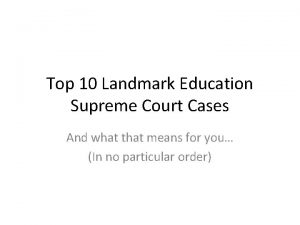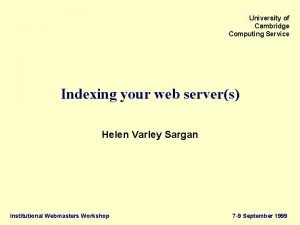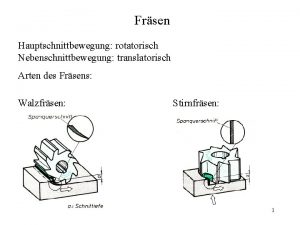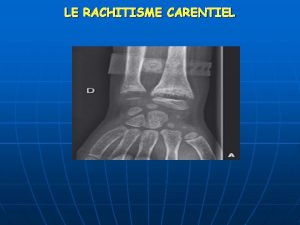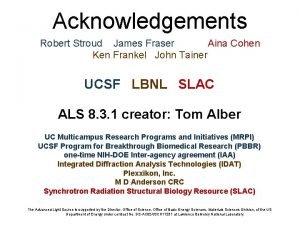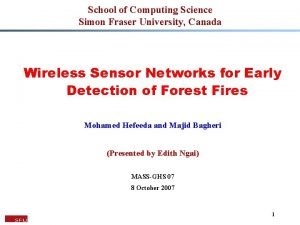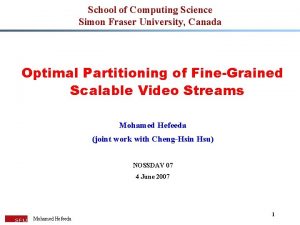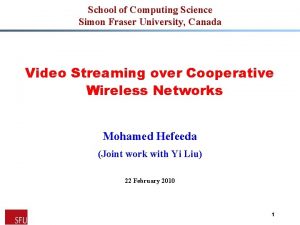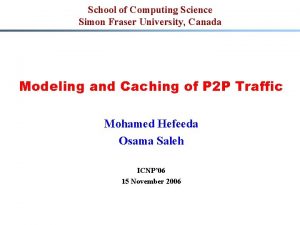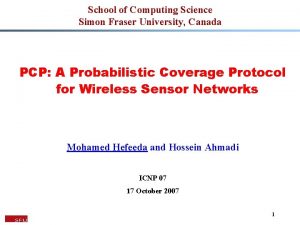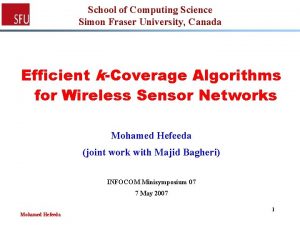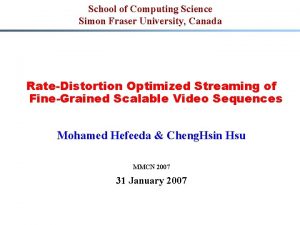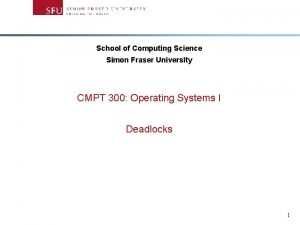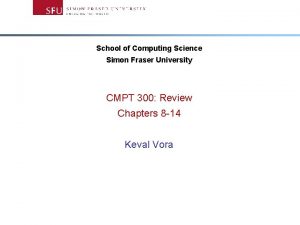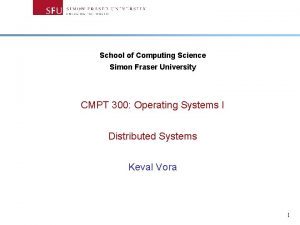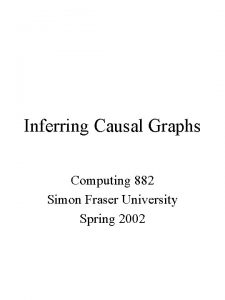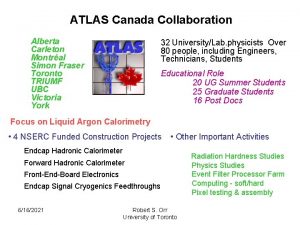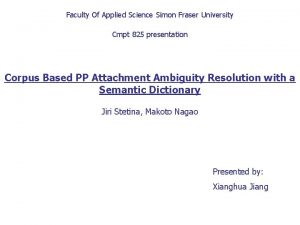School of Computing Science Simon Fraser University Canada





![Related Works § Network coding and scalable video coding [Chenguang 07, Zhao 06] - Related Works § Network coding and scalable video coding [Chenguang 07, Zhao 06] -](https://slidetodoc.com/presentation_image_h2/367efdb1b44d4148abe5aad0aa217673/image-6.jpg)

















![References § [Gkantsidis 05] C. Gkantsidis and P. Rodriguez. Network coding for large scale References § [Gkantsidis 05] C. Gkantsidis and P. Rodriguez. Network coding for large scale](https://slidetodoc.com/presentation_image_h2/367efdb1b44d4148abe5aad0aa217673/image-24.jpg)
- Slides: 24

School of Computing Science Simon Fraser University, Canada Live P 2 P Streaming with Scalable Video Coding and Network Coding Mohamed Hefeeda (Joint work with Shabnam Mirshokraie) 22 February 2010 Mohamed Hefeeda 1

Motivations § Wide deployment of P 2 P streaming systems - PPLive, UUSee, Sop. Cast, Cool. Streaming, …. § Users demand better video quality - Higher resolution, frame rate, fidelity § However, P 2 P systems face multiple challenges - Limited upload capacity (ADSL, Cable) - High churn rate - Diverse receivers • Screen resolutions, bandwidth, CPU capacity Mohamed Hefeeda 2

Motivations § To provide better quality, we need to: § Deploy more resources (seed servers) AND/OR § Efficiently manage current resources - Maximize utilization of peers’ upload capacity - Customize multimedia content for diverse receivers - Adapt to network and peer dynamics - Our focus in this paper Mohamed Hefeeda 3

Our Work § Propose new design for P 2 P streaming systems § Employ both: Scalable Video Coding AND Network Coding - Performance benefits well beyond those achieved by each § Implementation and quantification of potential gain - Much higher (several d. Bs) visual quality - Smoother streaming rate - More streaming capacity - Higher robustness Mohamed Hefeeda 4

Related Works § Most currently deployed systems use single-layer videos § Network coding in P 2 P streaming systems [Wang 07, Feng 08, …] - Improve performance of single-layer videos - But limited support for heterogeneous receivers § Scalable video coding in P 2 P streaming systems [Lan 07, Cui 03, Rejaie 03, Hefeeda 08, … ] - Better support for heterogeneous receivers - But may not fully utilize peer’s capacity Mohamed Hefeeda 5
![Related Works Network coding and scalable video coding Chenguang 07 Zhao 06 Related Works § Network coding and scalable video coding [Chenguang 07, Zhao 06] -](https://slidetodoc.com/presentation_image_h2/367efdb1b44d4148abe5aad0aa217673/image-6.jpg)
Related Works § Network coding and scalable video coding [Chenguang 07, Zhao 06] - Assume static tree-based streaming systems - Solve integer linear programming to determine #layers for receivers in multicast sessions - Our work is for dynamic mesh-based streaming systems— the most common in practice - And we provide practical validation Mohamed Hefeeda 6

Brief Background § Scalable Video Coding (recent H. 264/SVC) - Multi-layer streams - Temporal, spatial, and quality scalability - Low overhead [Schwarz 07 ] - Efficient extraction and customization of streams Mohamed Hefeeda 7

Brief Background § Network Coding - Increases throughput - Reduces buffering delay - Improves robustness § Source and intermediate nodes encode data blocks § Receivers use coefficients to decode blocks § Encoding and decoding linear operations over finite fields Mohamed Hefeeda 8

Overview of Proposed System § Mesh-based P 2 P streaming system § Tracker - Matching peers viewing the same video stream • Multiple dynamic swarms § Source node (seed server) - Providing additional capacity - Distributing network-coded scalable video streams § Peers - Receiving clients - Sharing their upload bandwidth to serve others Mohamed Hefeeda 9

Peer Software Architecture: Receiver § Download Scheduler - Compute number of required encoded blocks § Progressive NC Decoder - Gauss-Jordan elimination - Multi-threaded § SVC Layer Manager § Sharing Buffer Mohamed Hefeeda 10

Peer Software Architecture: Sender § Random NC Encoder - Linear operations on blocks of each video layer separately - Reduces network coding complexity - Robustness - No need to have centralized knowledge § Upload Scheduler - Selects receivers (incentives) Mohamed Hefeeda 11

Source Node Architecture and Functions § Prepare video streams before introducing them into the system - Encoding a video stream into multiple layers - Equal-length segments • Network coding operations on individual segments - Fixed-size blocks • Different layers may contain different number of blocks Mohamed Hefeeda 12

Evaluation: Setup § Testing application to evaluate our implementation § Scalable Videos - Three: Sony Demo, Tokyo Olympics, NBC News - 5 scalable layers each - Average Y-PSNR from 35. 5 to 47. 6 d. B - Average bit rate from 325 to 850 kbps - CIF frames, frame rate of 30 fps § Network coding - Random network coding - Progressive decoding - Fixed block size for all layers Mohamed Hefeeda 13

Evaluation: Setup § P 2 P system - Highly-dynamic P 2 P streaming system - 1, 000 heterogeneous peers - High churn rates - Flash crowd scenarios - Practical upload/download bandwidth distribution [Liu 08] Mohamed Hefeeda 14

Evaluation: Setup § Comparing proposed system (SVC+NC) against - Scalable video coding (SVC) - Single layer video streams with network coding (SL+NC) - Single layer streams (SL) § Performance metrics - Average streaming rate - Average streaming quality Mohamed Hefeeda - Number of streaming 15

Evaluation: Average Streaming Rate § Less than 18% of peers receive rate of 200 kbps or less, § 50% of peers receive 600+ kbps Mohamed Hefeeda 16

Evaluation: Average Streaming Quality § More than 5 d. B quality improvement § More stable and smoother quality against SL and SL+NC Mohamed Hefeeda 17

Evaluation: Number of Served Requests More streaming capacity: up to 30% more requests served Mohamed Hefeeda 18

Evaluation: Fraction of Late Frames § Almost no peer with high fraction of late frames § 16% of peers with more than 80% of late frames in single layer streaming system Mohamed Hefeeda 19

Impact of Churn Rate on Video Quality § Improving the quality as more peers join - More throughput, providing more video layers - Efficient use of resources of the new peers Mohamed Hefeeda 20

Impact of Flash Crowd Arrivals § Demand for receiving video data more than available resources - Up to 5 d. B improvement - Low quality under very high peer arrival rates • Limited upload capacity Mohamed Hefeeda 21

Conclusions § New system for P 2 P streaming § Integration of network coding and scalable video coding - Supports receiver heterogeneity - Better utilization of peer upload bandwidth - More robust for network and peer dynamics § Evaluation study in realistic settings - Significant performance gain in • Visual quality • Average streaming rate • Streaming capacity • Adaptation to high peer dynamics Mohamed Hefeeda 22

Thank You! Questions? ? § More info at: http: //nsl. cs. sfu. ca/ Mohamed Hefeeda 23
![References Gkantsidis 05 C Gkantsidis and P Rodriguez Network coding for large scale References § [Gkantsidis 05] C. Gkantsidis and P. Rodriguez. Network coding for large scale](https://slidetodoc.com/presentation_image_h2/367efdb1b44d4148abe5aad0aa217673/image-24.jpg)
References § [Gkantsidis 05] C. Gkantsidis and P. Rodriguez. Network coding for large scale content distribution. In Proc. of IEEE INFOCOM’ 05, pages 2235– 2245, Miami, FL, March 2005. § [Wang 07] M. Wang and B. Li. Lava: A reality check of network coding in peer-to-peer live streaming. In Proc. Of IEEE INFOCOM’ 07, pages 1082– 1090, Anchorage, AK, May 2007. § [Feng 08] C. Feng and B. Li. On large-scale peer-to-peer streaming systems with network coding. In Proc. Of ACM Multimedia’ 08, pages 269– 278, Vancouver, Canada, October 2008. § [Chenguang 07] X. Chenguang, X. Yinlong, Z. Cheng, W. Ruizhe, and W. Qingshan. On network coding based multirate video streaming in directed networks. In Proc. Of IEEE International Conference on Performance, Computing and Communications (IPCCC’ 07), pages 332– 339, New Orleans, LA, April Mohamed Hefeeda 2007.
 Simon fraser university statistics
Simon fraser university statistics Bethel school district #43 v. fraser (1987)
Bethel school district #43 v. fraser (1987) John fraser courses
John fraser courses Bethel school district #43 v. fraser
Bethel school district #43 v. fraser What's your favourite subject at school
What's your favourite subject at school Conventional computing and intelligent computing
Conventional computing and intelligent computing Graduate school of engineering science osaka university
Graduate school of engineering science osaka university University canada west english requirements
University canada west english requirements Fsae michigan 2018 results
Fsae michigan 2018 results Sap university
Sap university University of cambridge computing service
University of cambridge computing service Cambridge platform
Cambridge platform Brainspoting
Brainspoting Henthorn v fraser
Henthorn v fraser Bethel v fraser summary
Bethel v fraser summary Walzenfräsen
Walzenfräsen Bethel v fraser oyez
Bethel v fraser oyez C dalrymple-fraser
C dalrymple-fraser Katriona fraser
Katriona fraser Munro fraser 5 point plan
Munro fraser 5 point plan Alison fraser
Alison fraser Chapelet costal
Chapelet costal Double vision
Double vision James fraser ucsf
James fraser ucsf Hemsley fraser project management
Hemsley fraser project management



